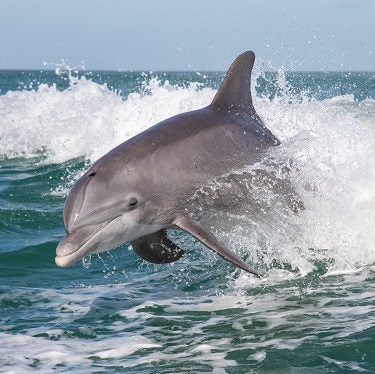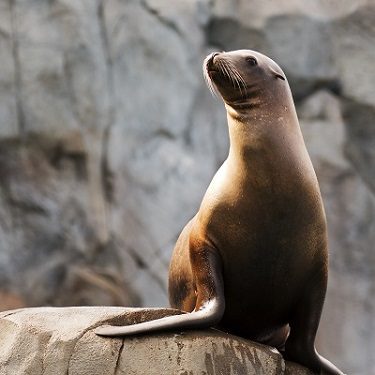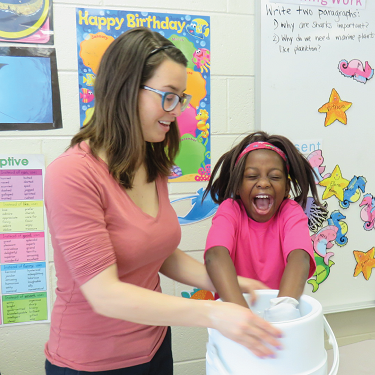Marine Life Encyclopedia
Marine Mammals
Minke Whale
Balaenoptera acutorostrata
Distribution
Worldwide in all latitudes
eCOSYSTEM/HABITAT
Open ocean
FEEDING HABITS
Filter feeders
TAXONOMY
Order Cetartiodactyla, Family Balaenopteridae
“Minke whale” refers to two existing species: the northern, or common, minke whale and the Antarctic minke whale. Aside from the differences in their range, the northern minke whale has a white band on its fin that the Antarctic minke whale does not. Minke whales reach lengths of up to 35 feet long and weigh up to 20,000 pounds, and female minkes tend to be larger than their male counterparts.
Minke whales are the most common of the great whale species, and can be found throughout the world’s oceans. Factors like age, maturity and sex dictate exactly where individuals will live. Older mature males tend to gravitate towards polar waters, where they’ll gather in groups of two or three. Mature females also migrate to colder waters, but swim closer to coastlines. Young minke whales are solitary and generally live in warmer, more central waters. Some groups of minke whales undertake large migrations, while others will stay in a smaller home range, though scientists aren’t sure why.
Minke whales are filter feeders, similar to right whales and humpback whales. Hairs on their baleen plates — Antarctic minke whales may have 200-300 plates on each side of their mouths — catch small fish or plankton, while the saltwater strains through to go back into the ocean. (NOAA) Unlike their relatives, minke whales are opportunistic eaters. They will usually feed on krill and small fish, but if those aren’t available they’ll hunt larger fish like haddock or cod.
Not much is known about the minke whale’s reproductive behavior. In northern oceans they may breed throughout the year, but birthing rates peak during the winter. Minke whales in other ocean regions may only breed during the winter. Minke whales gestate for 10 to 11 months and give birth to live young. Minke whale mothers will nurse their calves for four to six months before the calf switches to solid food.
The minke whale continues to be hunted in nations such as Iceland, Norway and Japan. Minke whales are listed as a species of least concern by the IUCN Red List in part due to a lack of data. Some of their populations have experienced declining numbers, but not enough to indicate that they are in danger of extinction.
Fun Facts About Minke Whales
1. Minke whales are the smallest of the “great whales,” growing to about 35 feet (10.6 m) long and weighing up to 20,000 pounds (9 tons).
2. Dwarf minke whales grow to a maximum length of 26 feet (8 m) and weight of 14,000 pounds (6.3 tons).
3. Minke whales are named after a Norwegian whaling spotter named Meincke, who allegedly mistook a minke for a blue whale.
4. Minke whales can stay submerged for at least 15 minutes before returning to the surface for air.
5. Minke whales live up to 50 years.1
Engage Youth with Sailors for the Sea
Oceana joined forces with Sailors for the Sea, an ocean conservation organization dedicated to educating and engaging the world’s boating community. Sailors for the Sea developed the KELP (Kids Environmental Lesson Plans) program to create the next generation of ocean stewards. Click here or below to download hands-on marine science activities for kids.
References:
Get Involved

Donate Today
SUPPORT OUR WORK TO PROTECT THE OCEANS BY GIVING TODAY
With the support of more than 1 million activists like you, we have already protected nearly 4 million square miles of ocean.

TAKE ACTION NOW
Support policy change for the oceans
Decision-makers need to hear from ocean lovers like you. Make your voice heard!

VISIT OUR ADOPTION CENTER
SYMBOLICALLY ADOPT AN ANIMAL TODAY
Visit our online store to see all the ocean animals you can symbolically adopt, either for yourself or as a gift for someone else.

DOWNLOAD OCEAN ACTIVITIES
HELP KIDS DISCOVER OUR BLUE PLANET
Our free KELP (Kids Environmental Lesson Plans) empower children to learn about and protect our oceans!




